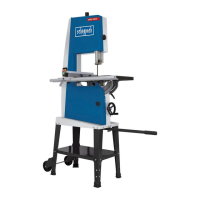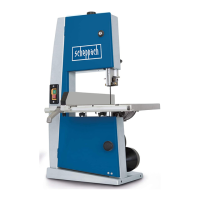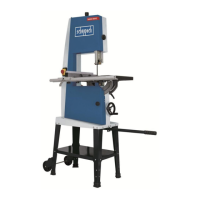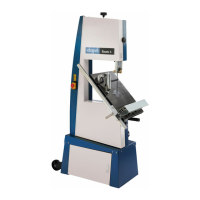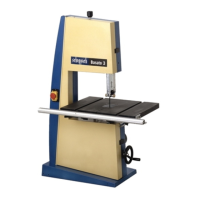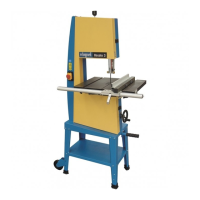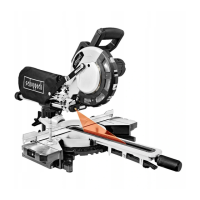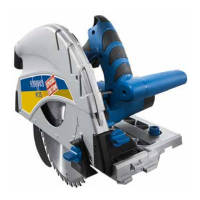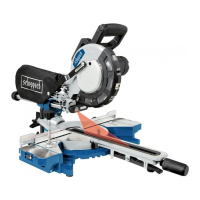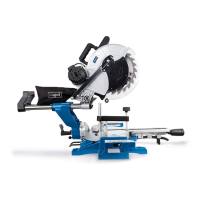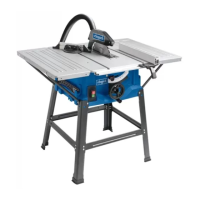27GB
• Move bottom support bearing (42) sufciently far
that it just no longer touches the Bandsaw blade
(22) (distance max. 0.5 mm).
• Retighten Allen screw for bottom support bearing
(41).
9.4.3. Adjusting the top guide rollers (37)
(Fig. 5+6)
• Undo Allen screws for top retainer (40)
• Move top retainer (39), top guide rollers (37), until
the front edge of the guide rollers (37) is approx. 1
mm behind the tooth base of the saw band.
• Retighten Allen screws for top retainer (40).
• Slide the guide rollers (37) in the direction of the
saw band! Important note! The distance between
the guide rollers (37) and saw band (22) must not
exceed 0.5 mm. (Saw band must not jam)
• Retighten Allen screws (38).
• Turn the top saw band roller (2) a few times in a
clockwise direction.
• Check the setting of the top guide rollers (38) again
and adjust if necessary.
• If necessary, adjust the top support bearing (36)
(9.4.1).
9.4.4. Adjusting the bottom guide pins (46)
(Fig. 7+8)
• Disassemble saw table (7)
• Undo screw for bottom retainer (43) (Open-ended
spanner, size 10)
• Move bottom retainer (47), bottom guide rollers
(46), until the front edge of the bottom guide roll-
ers (46) is approx. 1 mm behind the tooth base of
the saw band.
• Retighten screw for bottom retainer (43).
• Undo Allen screws for bottom guide rollers (45).
• Slide the two bottom guide rollers (46) sufciently
far in the direction of the saw band that the dis-
tance between the guide rollers (46) and saw band
(22) is max. 0.5 mm. (Saw band must not jam)
• Retighten Allen screws for bottom guide rollers
(45).
• Turn the bottom saw band roller (8) a few times in
a clockwise direction.
• Check the setting of the bottom guide rollers (46)
again and adjust if necessary.
• If necessary, adjust the bottom support bearing
(42) (9.4.2).
9.5. Adjusting the top saw band guide (5) (Fig. 9)
• Undo locking handle for saw band guide (24).
• Turn the adjustment handle for the saw band guide
(23) to lower the saw band guide (5) as closely as
possible (distance approx. 2-3 mm) over the ma-
terial to be cut.
• Retighten locking handle (24).
• Check the setting before every cutting process and
adjust if necessary.
9.6. Adjusting the saw table (7) to 90° (Fig. 10+11)
• Set the top saw blade guide (5) fully upwards.
• Loosen the locking handle for the saw table (21)
by turning counter-clockwise.
• Place the angle bracket between the Bandsaw
blade (22) and saw table (7). Angle bracket not
included in the scope of supply.
• Tilt the saw table (7) by turning, until the angle to
the Bandsaw blade (22) is precisely 90°. If the saw
table is already on the screw (49) and a 90° angle
cannot be set, undo the nut (50) and shorten the
screw (49) by turning in a clockwise direction.
• Tighten the locking handle for the saw table (21)
again by turning clockwise.
• Also undo the nut (50).
• Adjust the screw (49) sufciently that the saw table
touches the underside.
• Retighten the nut (50) to x the screw (49) in po-
sition.
• If necessary, set the scale pointer (51) to 0° on the
graduated scale (52). (Fig. 11)
9.7. Which saw band to use
The saw band supplied in the band saw is intended
for universal use. The following criteria should be
considered when selecting the saw band:
• It is possible to cut tighter radii with a narrow saw
band than with a wide saw band.
• A wide saw band is used if a straight cut is re-
quired. This is important in particular when cutting
wood. The saw band has a tendency to follow the
wood grain and therefore deviates easily from the
desired cutting line.
• Fine-toothed saw bands cut more smoothly, but
also more slowly than coarse saw bands.
ATTENTION: Never use bent or torn saw bands!
9.8. Replacing the saw band (Fig. 1a+1b+3+14)
• Set the saw band guide (5) at approx. half height
between the saw table (7) and machine frame (16).
• Undo the cover locking mechanisms (10+13) and
open the side covers (11).
• Remove the screw (34) in reverse order (g. 3)
• Relieve the Bandsaw blade (22) tension by turning
the clamping screw (1) anti-clockwise.
• Remove the Bandsaw blade (22) from the saw
band rollers (2+8) and through the slot in the saw
table (7).
• Place the new Bandsaw blade (22) centrally on
both saw band rollers (2+8). The teeth of the Band-
saw blade (22) must point downwards in the direc-
tion of the saw table (Fig. 6).
• Tension the Bandsaw blade (22) (see 9.2)
• Close the side cover (11) again.
• Fit the screw (34) with washer (33), spring washer
(32) and wing-nut (31) again (g. 3).
9.9. Replacing the table insert (Fig. 13)
In case of wear or damage, the table insert (6) must
be replaced; otherwise there is an increased risk of
injury.
• Remove the worn table insert (6) by lifting it up
and out.
• Installation of the new table insert takes place in
reverse order.
9.10. Extraction nozzle (Fig. 1b)
The band saw is equipped with an extraction nozzle
(20) 100/40 mm for chips.
Only operate the device with a suitable extraction
system. Check and clean the suction channels at
regular intervals.
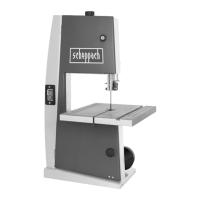
